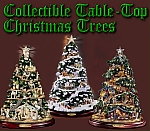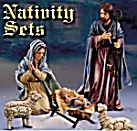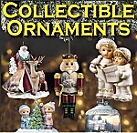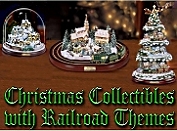Some of the first-ever Christmas ornaments that were made in Japan were pastboard houses. Often, those scenes have included buildings, figures, and accessories that must have "clashed" in every way with the Nativity display itself. Many included pasteboard houses that were sprinkled with clear glitter or crushed mica to represent snow.
In German-American culture, "putz" means to keep working with something until you're satisfied with it. As in "It's time to stop putzing around with that pattern and sew the dress." Holiday displays that families would set out relatively early and putter with until Christmas Eve came to be called "putzes." And to this day, collectors call those glittered, pasteboard houses "putz houses." (For more information about these houses, please refer to the Big Indoor Trains article What is a Glitterhouse?)
In many families the putzes included electric trains. For an article that discusses this phenomenon, in more detail, please see our article "What Do Trains Have To Do With Christmas?".)
To this day, those pasteboard houses are still called "putz houses" by many collectors.
 Commercial Nativity Products - Of course, many families a century ago couldn't have afforded to set up a Nativity even if they wanted to. But according to the Woolworths Virtual Museum web site, Woolworths started selling affordable little Nativity statuettes about 1930. The manufacturers kept the costs down by making the figures of plaster of paris and spraying them rather than brush-painting. This way the figures could sell for a few cents each. Even families that had almost no money coming in during the Great Depression could afford to add at least one figurine to their Nativity every Christmas season.
Commercial Nativity Products - Of course, many families a century ago couldn't have afforded to set up a Nativity even if they wanted to. But according to the Woolworths Virtual Museum web site, Woolworths started selling affordable little Nativity statuettes about 1930. The manufacturers kept the costs down by making the figures of plaster of paris and spraying them rather than brush-painting. This way the figures could sell for a few cents each. Even families that had almost no money coming in during the Great Depression could afford to add at least one figurine to their Nativity every Christmas season.
 By the time I was old enough to pay attention to such things, my Dad considered it a sort of tradition to go to the "five-and-ten-cent" store each December and find one more person or animal. But by the late sixties, the plaster of paris figures were being replaced by figures made of "composite" (a kind of rubbery paper mache). They were nice looking but didn't always look right by our plaster people. And it wasn't much longer before the "five-and-ten-cent" stores stopped carrying individual figures altogether and started selling cheap plastic sets.
By the time I was old enough to pay attention to such things, my Dad considered it a sort of tradition to go to the "five-and-ten-cent" store each December and find one more person or animal. But by the late sixties, the plaster of paris figures were being replaced by figures made of "composite" (a kind of rubbery paper mache). They were nice looking but didn't always look right by our plaster people. And it wasn't much longer before the "five-and-ten-cent" stores stopped carrying individual figures altogether and started selling cheap plastic sets.
 Fontanini Nativities - About 1908, in Bagni di Lucca, Italy, the Fontanini family added Nativity sets to the family's line of high-quality sculptures. Unlike the plaster-of-paris Nativities, in which the figures' arms tend to be clasped to their chest or otherwise protected from breakage, Fontanini figures adopt dramatic poses similar to the poses in many renaissance paintings.
Fontanini Nativities - About 1908, in Bagni di Lucca, Italy, the Fontanini family added Nativity sets to the family's line of high-quality sculptures. Unlike the plaster-of-paris Nativities, in which the figures' arms tend to be clasped to their chest or otherwise protected from breakage, Fontanini figures adopt dramatic poses similar to the poses in many renaissance paintings.
Today, many Fontanini Nativity sets have figures made of high-quality plastic, so they are virtually unbreakable, but they demonstrate  the same attention to detail as their more fragile ancestors. One of the signs that Fontanini Nativities have made an impact on American culture is that many of the other brands today seem inspired by Fontanini originals.
the same attention to detail as their more fragile ancestors. One of the signs that Fontanini Nativities have made an impact on American culture is that many of the other brands today seem inspired by Fontanini originals.
In the meantime, though, Fontanini keeps offering new figures every year in several different sizes. So someone who wanted to start with the Holy Family and add a few pieces at a time can still do just that. Fontanini also sells elaborate settings that show off their collections.
Many, Many Others - Of course, once Nativity sets became popular and available, a thousand other kinds became available.

- Other Artists and Studios and Materials - There are certainly too many manufacturers and Nativity sets to count these days, and they use a wide range of materials from plastic to the best quality ceramic. The photo at the right is my sister-in-law's bone china set. It differs from the Fontanini and Fontanini-inspired sets in that the figures' positions are relatively sedate.
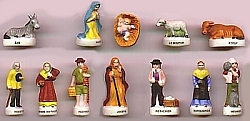
- Other Cultures - Other cultures have their own Nativity traditions.
- For example, folks in Provence used to imagine that Bethlehem wasn't so different than their own small villages. So French Nativities often include relatively modern French Country townspeople and tradepeople as well as the traditional, robed, Bible characters. (Click here to read more about traditional nativities in Provence.)
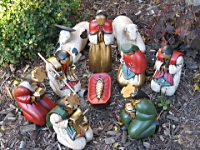 Similarly, Latin Americans often provide their Nativity figures with costumes and appearances that suit their own regions and people. Many beautiful handmade Latin Nativities have been carved or fired over the years.
Similarly, Latin Americans often provide their Nativity figures with costumes and appearances that suit their own regions and people. Many beautiful handmade Latin Nativities have been carved or fired over the years.
- Whimsical Nativities - Most of Nativities discussed so far seem intended to inspire a devotional response. Within last few decades, however, a growing number
 of Nativity sets seem intended to evoke other responses. Nativity sets in which the figures look liked children may be charming. In addition to the set shown on the right, we also own a resin Nativity set that represents ragged (Boyd's) teddy bears dressed up as though they are putting on a Christmas pageant. I grew up with "devotional" Nativites, but I don't mind the "charming" or "whimsical" ones as long as they are still in good taste.
of Nativity sets seem intended to evoke other responses. Nativity sets in which the figures look liked children may be charming. In addition to the set shown on the right, we also own a resin Nativity set that represents ragged (Boyd's) teddy bears dressed up as though they are putting on a Christmas pageant. I grew up with "devotional" Nativites, but I don't mind the "charming" or "whimsical" ones as long as they are still in good taste.
Conclusion
This page is meant mostly to get you thinking about why Nativities are important in so many families' Christmas celebrations, and why they are important to you.
Since we wrote this article, we have added a charming article from author, teacher, and musician Tess Hoffman, 